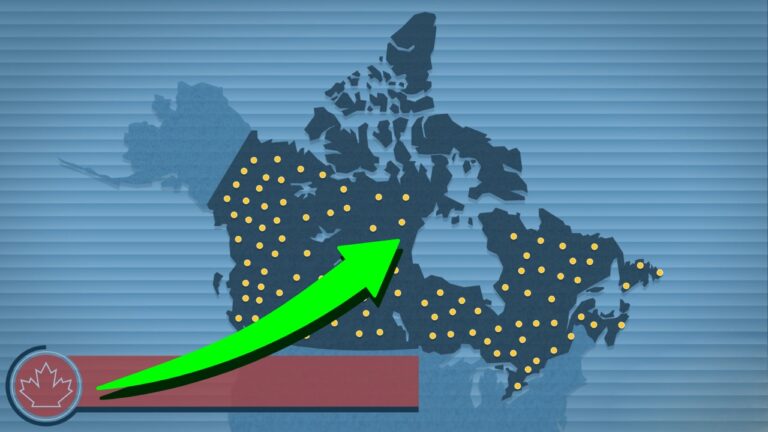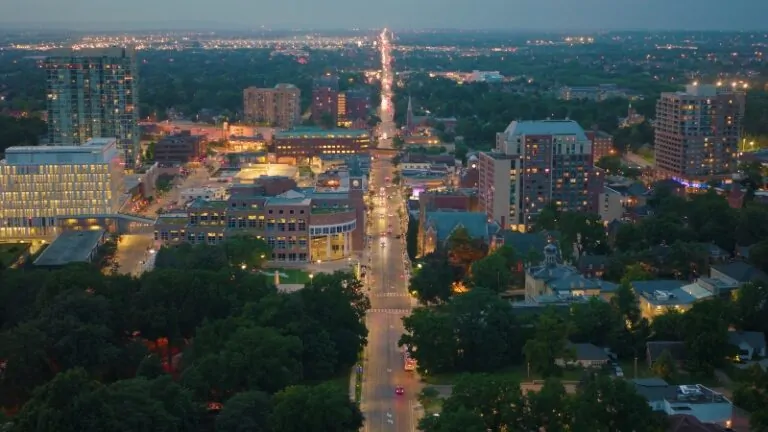In the first quarter of 2024, Canada reached a significant milestone as its population surpassed 41 million, hitting 41,012,563 by April 1. This notable increase of 242,673 people, representing a 0.6% growth, was largely driven by international migration.
But there are other sources that don’t agree with these numbers. According to Worldometar, Canada’s population is 39,102,134 as of Wednesday, June 26, 2024,
The Maritime provinces—Nova Scotia, New Brunswick, and Prince Edward Island—welcomed their highest number of immigrants in any quarter since 1971, showcasing a nationwide trend of growing diversity.
Meanwhile, Alberta continued its streak as a top destination within Canada, attracting the most interprovincial migrants for the 11th consecutive quarter.
Table of Contents
TogglePopulation Share of Major Canadian Cities (2023-2024)
These are the 17 most populated cities in Canada according to StatisticsTimes.
| City | Population 2023 | Population 2024 | Share of Canada’s Population (%) |
|---|---|---|---|
| Toronto | 6,371,958 | 6,431,430 | 16.4 |
| Montréal | 4,307,958 | 4,341,638 | 11.1 |
| Vancouver | 2,657,088 | 2,682,509 | 6.86 |
| Calgary | 1,639,613 | 1,665,023 | 4.26 |
| Edmonton | 1,544,448 | 1,567,615 | 4.01 |
| Ottawa-Gatineau | 1,437,188 | 1,451,571 | 3.71 |
| Québec | 844,249 | 851,061 | 2.18 |
| Winnipeg | 841,108 | 849,251 | 2.17 |
| Hamilton | 781,047 | 786,843 | 2.01 |
| Kitchener-Cambridge-Waterloo | 585,990 | 593,035 | 1.52 |
| London | 518,503 | 522,505 | 1.34 |
| St. Catharines-Niagara | 423,630 | 426,730 | 1.09 |
| Halifax | 419,882 | 422,891 | 1.08 |
| Oshawa | 410,430 | 414,405 | 1.06 |
| Victoria | 397,703 | 401,577 | 1.03 |
| Saskatoon | 342,409 | 347,377 | 0.888 |
| Windsor | 341,635 | 344,018 | 0.880 |
Growth in Early 2024
In the first quarter of 2024, Canada’s population grew by 242,673 people, marking a quarterly increase of 0.6%. This growth rate mirrors the figures from both the fourth quarter of 2023 and the first quarter of 2023, each showing a steady 0.6% rise as per Canadian government sources.
Keeping with recent patterns, a staggering 99.3% of this increase (equivalent to 240,955 people) came from international migration, encompassing both permanent and temporary immigration.
This surge aligns with the Immigration, Refugees, and Citizenship Canada (IRCC) targets for 2024. Most of the temporary immigration growth occurred before new caps were announced on non-permanent resident (NPR) permits for the year.
If temporary immigration were excluded, Canada’s population growth rate for the first quarter of 2024 would have been just 0.3%.
Historically, from 2001 to 2021, the first quarter growth rate varied between 0.1% and 0.3%, highlighting the significant impact of recent immigration trends.
Canada’s population, making up 0.48% of the total world population, ranks 38th among countries and dependencies.
With a population density of just 4 people per square kilometer (11 per square mile), it’s one of the world’s least densely populated countries, spread across a vast land area of 9,093,510 square kilometers (3,511,022 square miles).
Despite this, Canada is highly urbanized, with 81.4% of its population, about 31.6 million people, living in cities as of 2023. The median age in Canada is 40.6 years, reflecting its mature demographic profile.
Alberta Leads in Interprovincial Migration Gains
In the first quarter of 2024, Alberta continued to be the top gainer from interprovincial migration, despite a slower overall migration rate. A total of 89,408 migrants moved between provinces and territories, an 8.7% decrease from the same period in 2023 when 97,917 people relocated reflecting on the source of Calgary CTV News.
Most provinces and territories experienced net losses in interprovincial migration during this period, with notable exceptions being Alberta (+12,482), New Brunswick (+1,627), and Yukon (+60). This marks the 11th consecutive quarter of net gains for Alberta, a stark contrast to the 19 out of 24 quarters of losses between the third quarter of 2015 and the second quarter of 2021.
The primary contributors to Alberta’s net gain were individuals moving from Ontario (9,398) and British Columbia (9,218). Conversely, those leaving Alberta predominantly moved to British Columbia (5,744) and Ontario (3,893).
Meanwhile, Ontario faced its 10th consecutive quarter of net losses in interprovincial migration, with a net loss of 9,020 people in the first quarter of 2024 according to Ontario’s official government website.
This continues a trend of 17 straight quarters of net losses for Ontario since the first quarter of 2020.
Temporary Immigration Trends in Early 2024
We saw an influx of 131,810 non-permanent residents (NPRs) in the first quarter of 2024, which is higher than the 108,435 added in the same period last year.
However, this net increase is one of the smallest since the surge in temporary migration began in mid-2022, and it’s notably lower than the record highs of the second and third quarters of 2023, which saw increases of 233,361 and 312,758 respectively.
Every province and territory experienced a rise in NPRs, except for Prince Edward Island and New Brunswick, which saw slight decreases of 338 and 218 respectively.
As of April 1, 2024, the total number of NPRs in Canada reached a record high of 2,793,594.
This includes 2,430,282 permit holders (work or study) and their families, and 363,312 asylum claimants and related groups as noted by Edana Robitaille from CIC News.
In the first quarter of 2024, the number of people holding only work permits increased by 94,299, while those holding only study permits decreased by 24,594. Although it’s normal for the number of study permit holders to drop in the first quarter, the decrease in 2024 was larger than the 16,003 decrease seen in the same period last year.
Canada’s Aging Population and Future Predictions Reaches Over 63 Million
Canada’s population is on a significant aging trend, with the number of people aged 85 and older expected to triple by 2073, reaching as many as 4.3 million. This demographic shift will introduce new pressures on the country, according to Ottawa-based demographer Doug Norris.
Statistics Canada’s projections indicate that by 2073, the total population could hit 63 million, with at least 3.3 million over 85.
Migration is set to be the primary driver of Canada’s growth, as natural increase—births minus deaths—will play a minor role due to low birth rates and an aging population. Norris highlights that the senior population will exert double the pressure on the labor market, as aging individuals transition from workers to requiring more services.
The demand for long-term care and health services will surge, necessitating more workers in these sectors.
Norris emphasizes the importance of planning population growth to meet these specific labor needs.
While the aging trend will affect all provinces and territories, some regions will maintain or even grow their populations better than others. British Columbia, Alberta, and Saskatchewan are expected to increase their share of Canada’s population, whereas Newfoundland and Labrador, Nova Scotia, New Brunswick, and Quebec may experience population declines.
B.C. Premier David Eby stresses the need for federal support to build infrastructure to accommodate this growth. He notes that federal policies driving population increases must be matched with adequate infrastructure funding to ensure that provinces like B.C. can sustain their growth effectively.
Norris also points out the disparity within provinces, with major cities attracting most of the growth, which could strain housing and services, while rural areas might continue to decline. He underscores the necessity for decision-makers to consider individual community projections to address these diverse challenges comprehensively.
Challenges Faced Due to Rapid Population Growth
This population growth is the fastest in 67 years and has introduced several significant challenges.
Housing Shortage
- Canada needs to build 170,000 new housing units every three months to match population growth says Financial Post.
- The industry is currently struggling to complete 220,000 units in an entire year, indicating a substantial shortfall.
Strain on Infrastructure
- The rapid increase in population places a heavy burden on existing infrastructure, including healthcare and schools.
- The supply side of the economy, like housing and service infrastructure, is unable to keep pace with the fast population growth.
Economic Pressure
- The influx of immigrants, while beneficial for filling job vacancies, presents a shock to the economic system due to the sheer number of people arriving in a short period.
- There is a mismatch between rapid population growth and the gradual pace at which the economy can expand its supply side.
Inflation and Cost of Living
- The rapid population increase exacerbates inflationary pressures, particularly evident in the rising costs of rent, services, and housing.
Policy Response
- Ottawa plans to cap the number of new temporary residents and reduce international student visas to alleviate housing and cost-of-living pressures.
- Economists suggest that this policy change could reduce population growth to a more manageable 1%, easing inflation and potentially leading to a Bank of Canada rate cut, but it may also result in slower GDP growth.
Top 5 Biggest Cities And Their Statistics
1. Toronto
Toronto, the capital city of Ontario, remains Canada’s most populated city.
In 2024, its population is estimated to be around 2.91 million. This vibrant metropolis, known for its diverse economy and cultural richness, is also the fourth-largest city in North America.
However, the city has also seen a rise in car thefts, with the top 10 most stolen vehicles being a significant concern for residents.
The Greater Toronto Area (GTA) significantly contributes to Ontario’s economy, producing over half of the country’s manufactured goods and exports.
The city’s diverse economy spans sectors such as finance, technology, and arts, drawing both local and international talent.
Despite its rapid growth, Toronto faces challenges in housing and infrastructure, reflecting a population density of 4,334 people per square kilometer.
2. Montréal
Montréal, with a population of approximately 4.34 million in 2024, remains a central hub of culture and commerce in Quebec.
The city’s growth rate of 0.78% from the previous year highlights its steady attraction of immigrants and businesses alike.
As the second-largest city in Canada, Montréal balances a rich historical heritage with a dynamic, modern economy, particularly strong in aerospace, technology, and arts sectors.
3. Vancouver
Vancouver, renowned for its stunning natural surroundings, has a population of about 2.68 million in 2024.
The city continues to grow, with a 0.96% increase from the previous year. While Vancouver’s crime rate is relatively low compared to other major cities, the economy thrives on industries such as film, tech, and natural resources.
The city’s appeal lies not only in its economic opportunities but also in its high quality of life, drawing people from around the world.
4. Calgary
Calgary’s population reached 1.67 million in 2024, reflecting a 1.55% growth rate.
Known for its strong presence in the energy sector, Calgary continues to attract professionals and families seeking employment and a high standard of living.
The city’s robust economic base and strategic location make it a significant contributor to Alberta’s overall growth.
5. Edmonton
Edmonton, with a population of 1.57 million in 2024, grew by 1.50% from the previous year according to CBC.
Key statistics about Edmonton’s crime rate reflect ongoing efforts to ensure safety amidst its economic dynamism.
As Alberta’s capital, Edmonton is a key player in the province’s economy, particularly in industries like oil, education, and healthcare.
The city’s growth underscores its role as a central hub for innovation and economic activity in the region.



















